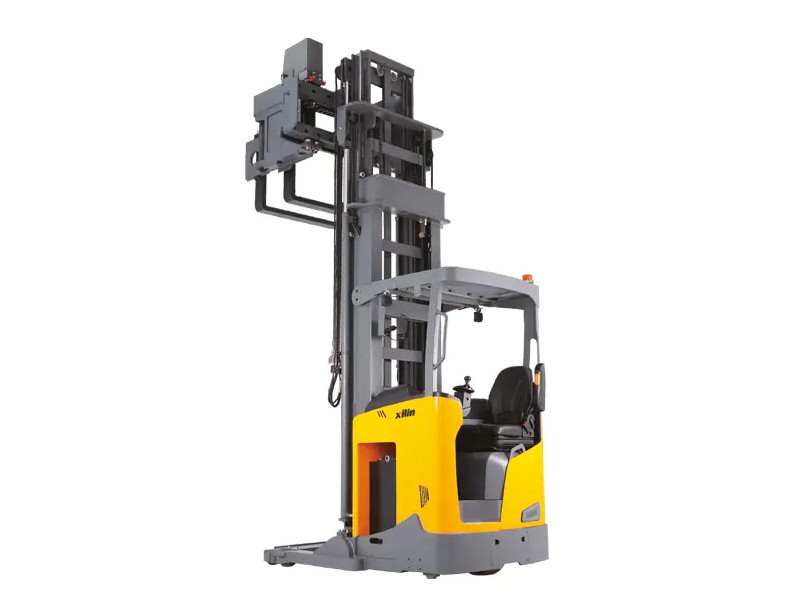Tri-Lateral Stackers (also known as tri-directional stackers) offer significant advantages in efficiency and ease of operation, primarily in the following areas:
High Efficiency: Thanks to their unique mast structure and operating method, Tri-Lateral Stackers can access cargo by shifting their forks left and right and rotating them 180°, without requiring a full turn, significantly improving operational efficiency. This method reduces the need for traditional forklifts to frequently maneuver in confined spaces, increasing both speed and efficiency.
Ease of Operation: Tri-Lateral Stackers are designed with ergonomic considerations, including a comfortable and convenient operating environment and clear visibility, all of which enhance ease and comfort. For example, some models are equipped with a fork vision system and wheel display, making it easier for the operator to observe and operate. Furthermore, their simple operation and quick response contribute to improved work efficiency.
High Space Utilization: Tri-Lateral Stackers can operate in narrow aisles, requiring less aisle width than traditional forklifts, thereby improving warehouse space utilization.
High Adaptability: Tri-Lateral Stackers are suitable for a variety of storage environments, including dense storage warehouses, cold chain warehouses, and e-commerce warehouses, adapting to different storage needs.
Applicable Environments and Operating Conditions of Tri-Lateral Stackers
Tri-Lateral Stackers (also known as three-way stackers) are highly efficient equipment widely used in warehousing and logistics. Their design and features enable them to demonstrate excellent adaptability and flexibility in a variety of operating environments.
1. Applicable Environments
Tri-Lateral Stackers are suitable for a variety of warehousing and logistics environments, including:
Warehouses and Logistics Centers: Tri-Lateral Stackers are widely used in various types of warehouses, logistics centers, and distribution centers for stacking, moving, palletizing, and depalletizing goods. Their efficient operation and high space utilization make them an indispensable piece of equipment in modern warehousing and logistics.
Cold Chain and Food Industry: Tri-Lateral Stackers are highly adaptable in industries with high temperature and hygiene requirements, such as cold chain transportation, food processing, and pharmaceutical warehousing. Some models also feature explosion-proof, dust-proof, and moisture-proof features to meet the needs of operations in special environments.
Industrial and Manufacturing: In factories and manufacturing bases, Tri-Lateral Stackers are used for handling and stacking raw materials, semi-finished products, and finished products, improving production efficiency and operational safety.
Special Environment Operations: Some models of Tri-Lateral Stackers feature explosion-proof, dust-proof, moisture-proof, and anti-static features, making them suitable for special operating environments such as the chemical, petroleum, electronics, and military industries.
2. Operating Conditions
The operating conditions of a Tri-Lateral Stacker involve multiple factors, including the surface, environment, temperature, and cargo characteristics. These factors are as follows:
Surface Conditions: The surface should be flat and firm, free of obvious potholes, cracks, or obstructions, to ensure stable and safe operation. The surface should be free of accumulated water, oil, mud, or other contaminants that may affect the stability of the equipment's movement and operation.
Working Environment: Tri-Lateral Stackers are suitable for indoor or semi-enclosed environments, such as warehouses, workshops, and logistics centers. In environments with high humidity, dust, corrosive gases, or high temperatures and humidity, equipment with explosion-proof, dust-proof, and corrosion-resistant features is required.
Temperature: The working temperature should be controlled within the equipment's tolerances. Excessively high or low temperatures may affect equipment performance and service life. Equipment with appropriate protective features is required for use in extreme temperature conditions (such as cold storage and high-temperature workshops).
Cargo Characteristics: Tri-Lateral Stackers are suitable for handling regularly shaped, well-packaged cargo, such as pallets, boxes, and bags. For special cargo, such as fragile, flammable, or explosive cargo, equipment with appropriate protective features is required.
Working Space and Aisle Requirements: Tri-Lateral Stackers have relatively low aisle width requirements and are suitable for operation in narrow aisles, improving space utilization. The working aisle should be kept clear of obstructions to ensure safe operation.
Operational Efficiency and Safety
Tri-Lateral Stackers improve operational efficiency and safety through their efficient operating performance and superior safety features:
High Operational Efficiency: Optimized workflow and operation methods improve efficiency and reduce work time.
Operational Convenience: Ergonomic design, a clear user interface, and safety features enhance operational convenience and safety.
Safety: Features such as anti-collision, anti-fall, anti-slip, and explosion-proofing ensure the safety of both operators and equipment.
Tri-Lateral Stackers are highly efficient equipment suitable for a variety of warehousing and logistics environments. Their wide range of applications and flexible operating conditions meet the needs of diverse industries and scenarios. By properly selecting equipment configuration and operating conditions, operational efficiency and safety can be effectively improved, making them an indispensable component of modern warehousing and logistics.











